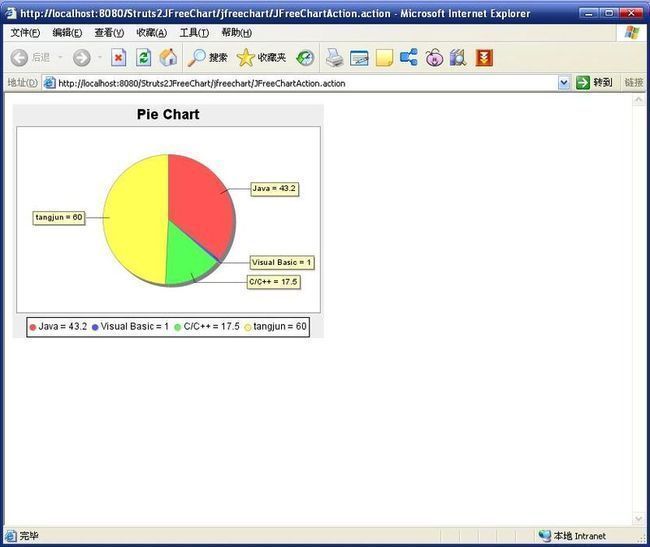Struts2+JFreeChart制作图标
前言
关于Struts2入门以及提高等在这里就不介绍了,但是关于Struts2的学习有以下推荐:
-
- struts2-showcase-2.0.6.war:这个是官方自带的Demo(struts-2.0.6-all.zip\struts-2.0.6\apps目录下),非常全面,直接部署就可以了(很多朋友Struts2能学很好我估计还是直接从这里学来的)。
- wiki-WebWork:入了门的朋友应该都知道,strust2由webwork2和struts1.x合并起来的,但主要还是以webwork2为主,所以如果找不到Struts2的资料可以找WebWork资料看看。
- Max On Java的博客,他的博客的资料在中文的Struts2算是比较全的了,写得很详细。
- The Code Project、Google - CodeSearch、Koders:这几个代码搜索网站在我找不到中文资料甚至英文文章的时候帮了我大忙!
关于JFreeChart入门等这里我也不打算介绍了,中文资料很多了。
正题
下面以边帖图片和代码的方式来讲解Struts2与JFreeChart的整合。
搭建环境:首先帖一张工程的目录结构以及所需的jar包。注意:如果你不打算自己写ChartResult的话只需要引入struts2-jfreechart-plugin-2.0.6.jar(这个在struts-2.0.6-all.zip可以找到了):

1.依次帖web.xml、struts.xml、struts.properties和struts-jfreechart.xml几个配置文件的代码:
web.xml
< web-app version ="2.4"
xmlns ="http://java.sun.com/xml/ns/j2ee"
xmlns:xsi ="http://www.w3.org/2001/XMLSchema-instance"
xsi:schemaLocation ="http://java.sun.com/xml/ns/j2ee
http://java.sun.com/xml/ns/j2ee/web-app_2_4.xsd" >
< filter >
< filter-name > struts2 </ filter-name >
< filter-class >
org.apache.struts2.dispatcher.FilterDispatcher
</ filter-class >
</ filter >
< filter-mapping >
< filter-name > struts2 </ filter-name >
< url-pattern > /* </ url-pattern >
</ filter-mapping >
</ web-app >
<! DOCTYPE struts PUBLIC
"-//Apache Software Foundation//DTD Struts Configuration 2.0//EN"
"http://struts.apache.org/dtds/struts-2.0.dtd" >
< struts >
< include file ="struts-jfreechart.xml" />
</ struts >
"-//Apache Software Foundation//DTD Struts Configuration 2.0//EN"
"http://struts.apache.org/dtds/struts-2.0.dtd" >
< struts >
< package name ="jFreeChartDemonstration" extends ="struts-default"
namespace ="/jfreechart" >
< result-types >
< result-type name ="chart" class ="org.apache.struts2.dispatcher.ChartResult" ></ result-type >
</ result-types >
< action name ="JFreeChartAction" class ="com.tangjun.struts2.JFreeChartAction" >
< result type ="chart" >
< param name ="width" > 400 </ param >
< param name ="height" > 300 </ param >
</ result >
</ action >
</ package >
</ struts >
2. 新建 JFreeChartAction继承 ActionSupport,生成JFreeChart对象并保存到chart中,注意这个名称是固定的。
import com.opensymphony.xwork2.ActionSupport;
import org.jfree.chart.ChartFactory;
import org.jfree.chart.JFreeChart;
import org.jfree.data.general.DefaultPieDataset;
public class JFreeChartAction extends ActionSupport {
/**
*
*/
private static final long serialVersionUID = 5752180822913527064L ;
// 供ChartResult调用->ActionInvocation.getStack().findValue("chart")
private JFreeChart chart;
@Override
public String execute() throws Exception {
// 设置数据
DefaultPieDataset data = new DefaultPieDataset();
data.setValue( " Java " , new Double( 43.2 ));
data.setValue( " Visual Basic " , new Double( 1.0 ));
data.setValue( " C/C++ " , new Double( 17.5 ));
data.setValue( " tangjun " , new Double( 60.0 ));
// 生成JFreeChart对象
chart = ChartFactory.createPieChart( " Pie Chart " , data, true , true , false );
return SUCCESS;
}
public JFreeChart getChart() {
return chart;
}
public void setChart(JFreeChart chart) {
this .chart = chart;
}
}
OK!至此代码已经全部贴完。
输入访问 http://localhost:8080/Struts2JFreeChart/jfreechart/JFreeChartAction.action
显示结果如下:
补充
以上生成的图片是PNG格式的图片,如果需要自定义图片格式的话(好像只能支持JPG和PNG格式),那么自己写一个ChartResult继承自StrutsResultSupport,见代码:
import java.io.OutputStream;
import javax.servlet.http.HttpServletResponse;
import org.apache.struts2.ServletActionContext;
import org.apache.struts2.dispatcher.StrutsResultSupport;
import org.jfree.chart.ChartUtilities;
import org.jfree.chart.JFreeChart;
import com.opensymphony.xwork2.ActionInvocation;
public class ChartResult extends StrutsResultSupport {
/**
*
*/
private static final long serialVersionUID = 4199494785336139337L ;
// 图片宽度
private int width;
// 图片高度
private int height;
// 图片类型 jpg,png
private String imageType;
@Override
protected void doExecute(String arg0, ActionInvocation invocation) throws Exception {
JFreeChart chart = (JFreeChart) invocation.getStack().findValue( " chart " );
HttpServletResponse response = ServletActionContext.getResponse();
OutputStream os = response.getOutputStream();
if ( " jpeg " .equalsIgnoreCase(imageType) || " jpg " .equalsIgnoreCase(imageType))
ChartUtilities.writeChartAsJPEG(os, chart, width, height);
else if ( " png " .equalsIgnoreCase(imageType))
ChartUtilities.writeChartAsPNG(os, chart, width, height);
else
ChartUtilities.writeChartAsJPEG(os, chart, width, height);
os.flush();
}
public void setHeight( int height) {
this .height = height;
}
public void setWidth( int width) {
this .width = width;
}
public void setImageType(String imageType) {
this .imageType = imageType;
}
}
如此的话还需要小小的修改一下struts-jfreechart.xml:
"-//Apache Software Foundation//DTD Struts Configuration 2.0//EN"
"http://struts.apache.org/dtds/struts-2.0.dtd" >
< struts >
< package name ="jFreeChartDemonstration" extends ="struts-default"
namespace ="/jfreechart" >
<!-- 自定义返回类型 -->
< result-types >
<!--
<result-type name="chart" class="org.apache.struts2.dispatcher.ChartResult"></result-type>
-->
< result-type name ="chart" class ="com.tangjun.struts2.chartresult.ChartResult" ></ result-type >
</ result-types >
< action name ="JFreeChartAction" class ="com.tangjun.struts2.JFreeChartAction" >
<!--
<result type="chart">
<param name="width">400</param>
<param name="height">300</param>
</result>
-->
< result type ="chart" >
< param name ="width" > 400 </ param >
< param name ="height" > 300 </ param >
< param name ="imageType" > jpg </ param >
</ result >
</ action >
</ package >
</ struts >
OK!显示的效果是一样的,只是图片格式不一样,当然这里面你可以做更多操作!
Struts2中POI在内存中生成文件并下载
POI是一个JAVA的实用jar包,可以生成excel文件,通常在web开发用于把数据库的数据生成excel文件,然后通过下载提供给用户。
本文结合struts2和poi,说明如何在内存中生成一个excel文件并下载到客户端。
首先进行jsp文件,struts.xml文件和action文件的内容说明,对于struts.xml文件的下载配置和action文件中的对应的方法名的设定还不熟悉的朋友可以先看前面这篇文章struts2中下载文件的方法。
文件名:download.jsp
文件位置:网站根目录下的work目录下
文件内容:
- < %@ page contentType="text/html; charset=gbk" %>
- < %@ taglib uri="/struts-tags" prefix="s"%>
- < html>
- < a href="excel.action">下载文件< /a>
- < /html>
struts.xml文件
文件内容:
- < ?xml version="1.0" encoding="UTF-8" ?>
- < !DOCTYPE struts PUBLIC
- "-//Apache Software Foundation//DTD Struts Configuration 2.0//EN"
- "http://struts.apache.org/dtds/struts-2.0.dtd">
- < struts>
- < package name="default" extends="struts-default">
- < action name="excel" class="ExcelDownloadAction">
- < result name="success" type="stream">
- < param name="contentType">application/vnd.ms-excel< /param>
- < param name="contentDisposition">attachment;filename="AllUsers.xls"< /param>
- < param name="inputName">excelFile< /param>
- < /result>
- < /action>
- < /package>
- < /struts>
然后是action文件
文件名:ExcelDownloadAction.java
文件内容:
- import java.io.ByteArrayInputStream;
- import java.io.ByteArrayOutputStream;
- import java.io.IOException;
- import java.io.InputStream;
- import org.apache.poi.hssf.usermodel.HSSFCell;
- import org.apache.poi.hssf.usermodel.HSSFRow;
- import org.apache.poi.hssf.usermodel.HSSFSheet;
- import org.apache.poi.hssf.usermodel.HSSFWorkbook;
- import com.opensymphony.xwork2.ActionSupport;
- @SuppressWarnings("serial")
- public class ExcelDownloadAction extends ActionSupport {
- public InputStream getExcelFile() {
- HSSFWorkbook workbook = new HSSFWorkbook();
- HSSFSheet sheet = workbook.createSheet("sheet1");
- {
- // 创建表头
- HSSFRow row = sheet.createRow(0);
- HSSFCell cell = row.createCell((short) 0);
- cell.setCellValue("id");
- cell = row.createCell((short) 1);
- cell.setEncoding(HSSFWorkbook.ENCODING_UTF_16);
- cell.setCellValue("姓");
- cell = row.createCell((short) 2);
- cell.setEncoding(HSSFWorkbook.ENCODING_UTF_16);
- cell.setCellValue("名");
- cell = row.createCell((short) 3);
- cell.setEncoding(HSSFWorkbook.ENCODING_UTF_16);
- cell.setCellValue("年龄");
- // 创建数据
- // 第一行
- row = sheet.createRow(1);
- cell = row.createCell((short) 0);
- cell.setCellValue("1");
- cell = row.createCell((short) 1);
- cell.setEncoding(HSSFWorkbook.ENCODING_UTF_16);
- cell.setCellValue("张");
- cell = row.createCell((short) 2);
- cell.setEncoding(HSSFWorkbook.ENCODING_UTF_16);
- cell.setCellValue("四");
- cell = row.createCell((short) 3);
- cell.setCellValue("23");
- // 第二行
- row = sheet.createRow(2);
- cell = row.createCell((short) 0);
- cell.setCellValue("2");
- cell = row.createCell((short) 1);
- cell.setEncoding(HSSFWorkbook.ENCODING_UTF_16);
- cell.setCellValue("李");
- cell = row.createCell((short) 2);
- cell.setEncoding(HSSFWorkbook.ENCODING_UTF_16);
- cell.setCellValue("六");
- cell = row.createCell((short) 3);
- cell.setCellValue("30");
- }
- ByteArrayOutputStream baos = new ByteArrayOutputStream();
- try {
- workbook.write(baos);
- } catch (IOException e) {
- // TODO Auto-generated catch block
- e.printStackTrace();
- }
- byte[] ba = baos.toByteArray();
- ByteArrayInputStream bais = new ByteArrayInputStream(ba);
- return bais;
- }
- @Override
- public String execute() throws Exception {
- // TODO Auto-generated method stub
- return super.execute();
- }
- }
蓝色的代码使用poi生成一个excel格式的内容,红色的代码通过字节数组的输入输出流的转换提供给客户端最终的输入流。